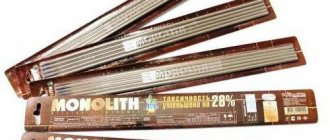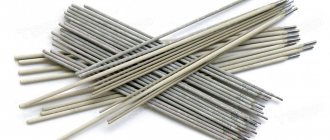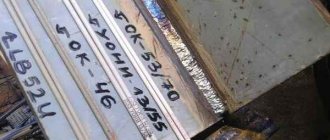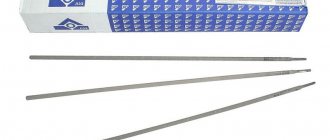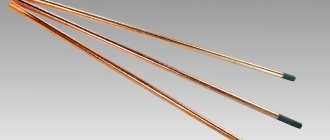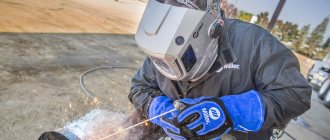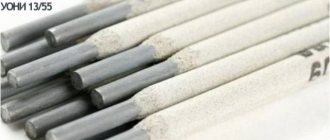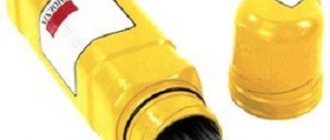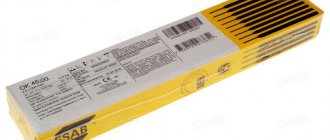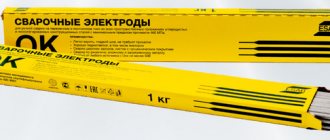Decoding the electrodes
The name of these welding electrodes comes from the abbreviation UONI-13, which denoted a coating for electrodes patented in 1940. It deciphers like this:
U – universal,
O - coating,
N – scientific,
And - the institute,
13 — № 13.
electrodes UONI 13 55
What is noteworthy is that GOST 9466 - 75 prescribed the use of a slightly different abbreviation - UONII-13 (“universal coating of scientific research institute No. 13”). Currently, any of these abbreviations may be indicated on packs of these consumables, but in documents it is always written UONII.
The manufacturer usually indicates the following code on the packages of UONI 13 55: E50A-UONI-13/55 SM-4.0-UD GOST 9467-60. This means that the product is an electrode for arc welding, the weld will have a strength of at least 50 kgf per mm2 and will have plastic properties, the product brand is UONI 13/55 SM, the diameter is 4 mm, carbon and low-carbon steels can be welded, electrode coating thick, the product is standardized according to GOST number 9467, approved in 1960.
decoding of markings
Depending on the type of electrodes of the UONI brand, the marking may vary. For example, the diameter can be 2 mm, 2.5 mm, 3 mm or 5 mm, tensile strength - e42, e46, e50, etc., modifications are 55k, 55r, 55u, etc.
You can read all about electrode markings here.
Purpose of electrodes UONI 13 55
welding using UONI Monolith
Welding electrodes UONI 13 55 are suitable for manual welding using an arc. Welding can be done in overhead, horizontal, lower, inclined positions, as well as in a vertical position from top to bottom. As mentioned above, they can weld low-alloy and carbon-containing metals. The welding seam is wear-resistant and protected from corrosion. The carbonates and fluoride compounds that make up the coating of the UONI electrode prevent the formation of hot cracks and give the weld plasticity and high impact strength. Therefore, this consumable is used when welding thick metal, correcting casting defects, and manufacturing parts that can withstand high pressure, low temperatures and long-term loads.
Electrodes Monolit UONI are widely used in shipbuilding.
Features of use
There are some nuances associated with the use of such devices in welding. Let's look at some of them:
- For welding it is necessary to use reverse polarity current;
- The coating is special, consisting of carbonates and fluoride formations, due to which the seams do not have gases and other harmful impurities;
- Low carbon steel contributes to significant weld durability;
- The absence of organic compounds prevents the formation of moisture on devices;
- In the manufacture of electrodes, the formation of various irregularities, cracks and other defects is completely eliminated.
The result is a strong seam that is not subject to aging and loss of properties when temperature conditions change. It is necessary to control the cleanliness of the connections, because the appearance of rust or oils leads to the formation of pores, and the connection will ultimately turn out bad.
Specifications
The coating of UONI 13 55 electrodes is basic. The rods consist of welding wire Sv-08 or Sv-08A. The ratio of the weight of the electrode to the weight of the deposited metal is 1.6 kg to 1 kg. Deposition rate - 9 g/Ah. Alloy includes carbon, sulfur, phosphorus, manganese and silicon.
The main mechanical properties of the UONI electrode are reflected in the table.
mechanical properties SSSI 13 55
The length of the products is 350 mm with a diameter of 2-3 mm and 450 mm with a diameter of 4-5 mm. The weight of an electrode with a diameter of 2 mm is 10 g. If the diameter is 2.5 mm, 3 mm, 4 mm, 5 mm, then the weight will be 17-18 g, 26-27 g, 59-61 g, 95 g, respectively.
The consumption of UONI electrodes is 10-15% lower compared to electrodes of some other brands, because their coating contains iron powder, which compensates for the metal burned out or splashed during welding.
Welding electrodes with the main type of coating, brand UONI13/55
Last updated: February 11, 2021 Author: Heron Library
In manual arc welding, welding electrodes with the main type of coating are widely used, the matrix of which is marble (based on calcium carbonate) and fluorspar (based on calcium fluoride) taken in a certain proportion. Calcium fluoride electrodes are mainly used in electrodes for welding the most critical structures, for example in the UONI13/55 electrode grades; UONI13/45; LB-52U; OK.53.70; ITS-4; ANO-TM; ANO-T…
The physical properties of the main coating of the electrodes determine the most complete removal of non-metallic inclusions from the weld metal, and the dissociation of carbonates provides reliable gas protection of the weld pool. Therefore, welded joints made with such electrodes must be ductile and highly resistant to cold cracks and brittle fracture. It is on the basis of the base coating that electrodes are produced that ensure a low content of diffusion hydrogen in the surfacing, the content of which can be used to comprehensively evaluate the level of development of the coating formulation, the quality of the raw materials used, and the technological level of the manufacturing plant.
For a general idea of the quality level of electrodes with a basic coating, currently produced by advanced electrode factories in Russia, they were randomly checked for the content of diffusion hydrogen (Hdif) in the surfacing. When checking electrodes of the UONI13/55 brand and its analogues (produced in the Russian Federation in 2014-2016) in the deposited metal, a strong scatter in the content of diffusion hydrogen was revealed from 7 to 16 cm3 per 100 g of deposit. For comparison, in surfacing performed by UONI13/55, mass-produced in the 80s, the Ndif content ranged from 3.5 to 6 cm3 per 100 g. The best, according to this characteristic, now include LB-52U electrodes (Kobe Steel ), produced in Japan - 1.5-2.5 cm3 per 100g. From the results obtained it is clear that the overall quality level of modern average electrodes with a basic coating has significantly decreased compared to those produced during the USSR.
The lower Ndif content is an important advantage that increases the resistance of the weld metal against corrosion and brittle fracture. Increasing requirements for the reliability of ship welded structures, the use of new high-strength steel grades, demands for durability of welded structures, and increasing volumes of welding work in the Far North are increasing the demand for electrodes with a basic coating. But only high-quality electrodes can ensure the reliability of welded structures operating under conditions of static and dynamic alternating loads, when the metal of the welds will have high impact strength at low temperatures and be distinguished by long-term strength (not prone to accelerated aging).
Along with the advantages, calcium fluoride electrodes also have significant disadvantages, sensitivity to pore formation when the coating is moistened, as well as to the presence of moisture or scale on the welded edges, low welding-technological properties (WTP), expressed in large-droplet transfer of electrode metal, and low arc stability, especially on alternating current. This is due to the presence of fluorine contained in fluorspar, which is part of the coating. An increase in its content leads to a decrease in the stability of arc combustion, and a decrease reduces the protection of the arc gap from hydrogen. Unfortunately, in recent years there has been a general trend towards reducing the fluorine content in electrode coating formulations; this gives manufacturers some improvement in the welding properties, but to the detriment of welding quality. It should be noted that electrodes cannot be assessed based only on STS; first of all, they must correspond to their purpose and declared characteristics.
Taking into account the shortcomings inherent in electrodes with a basic coating, JSC Geron has modified the UONI13/55 grade.
The resulting well-balanced slag system made it possible to reduce the droplet size during metal transfer and ensure a more stable arc combustion. At the same time, thanks to the high stabilizing properties of the coating, it was possible to increase the elasticity of the arc, which made it possible to weld in installation conditions from power sources with an open circuit voltage of 65 V on both direct and alternating current. Due to the technological advantages noted above, it is easier for the welder to manipulate the electrode and more easily control the welding process, and this helps to improve the quality of the seam. Chemical composition of the deposited metal, wt.%
| Chemical composition | Carbon | Silicon | Manganese | Sulfur | Phosphorus |
| Normative | no more than 0.12 | 0,18-0,6 | 0,65-1,6 | no more than 0.03 | no more than 0.035 |
| Typical | 0,09 | 0,30 | 1,05 | 0,011 | 0,024 |
Mechanical properties of deposited metal
| Mechanical properties (requirements) | Tensile strength, MPa | Yield strength, MPa | Relative extension, % | Impact strength, J/cm2 | ||||||
| KCV 00C | KCV -200C | KCV -400C | KCV -500C | KCU +200C | KCU -300C | KCU -600C | ||||
| GOST9467 (minimum) | 490 | 375 | 20 | — | — | — | 130 | 35 | — | |
| River Register (minimum) | 490-560 | 375 | 22 | 59 | — | — | — | — | — | — |
| Typical values | 530 | 440 | 30 | — | 155 | 122 | 110 | — | — | 123 |
Surfacing productivity, g/A*h
| Standard | 8,5-9,6 |
| Typical values | 9,1 |
UONI13/55 electrodes produced by Geron JSC are suitable for making high-quality filling and facing layers. At the same time, the typical content of Ndif in the deposited metal is 5-6 cm3 per 100 g of deposit, which meets the needs of the most demanding customers. The properties and technical characteristics of the electrodes fully comply with the requirements of GOST 9467 for electrodes of the E-50A type, as well as RD 03-613-03 and regulatory documents in force for technical devices of hazardous production facilities, therefore the electrodes are approved for use in the manufacture, reconstruction, installation and repair of a group of technical devices: PTO, KO, GO, OKHNVP, OTOG, SK, NGDO, MO, GDO. They are also approved for welding critical shipbuilding steels of normal strength with the River Register class (belong to category 3 of welding materials). The purpose and main technical characteristics of UONI13/55 electrodes, produced by JSC Geron, are comparable to the declared indicators of OK.53.70 ESAB electrodes.
Main coating UONI 13/55 E-50A
Difference between UONI and MR electrodes
Beginners often wonder which is better - SSSI 1355 or MP3. We hasten to clarify the situation.
Both grades are designed for joining carbon and low-carbon steels, the only difference is in the characteristics of the current required for welding. MP3 electrodes are used for welding with any type of current, and the polarity does not matter.
SSSIs can cook efficiently only with direct current; the polarity must be reversed. In this case, the constant cannot be replaced by a variable, otherwise the electrode will stick and the welding arc will not burn evenly. Considering this nuance, you can avoid metal spattering and weld defects.
Storage conditions and manufacturers
In order for products to retain their basic properties , they must be stored in appropriate premises. The relative humidity in the warehouse should always be at 50%, and the temperature should not exceed 14 degrees, which is achieved by using air conditioners. If the conditions are met, then the shelf life has no limitation.
The production of welding devices is carried out by such companies as LEZ, Spetselektrod, SZSM, Monolit. When purchasing, you must have a certificate of compliance with their standards. They are issued by the relevant authority.
Preparing the SSNI electrode for operation
If you assume that a special electrode such as SSSI does not require preparation before use, then you are deeply mistaken. A pack of consumables is not always spent at one time, and it may happen that some of the electrodes are waiting their turn in an already leaky package.
Then, in this case, before welding the metal, it is worth calcining the electrodes, since the UUNI coating tends to absorb moisture. You can use temperatures up to 300 - 400 degrees Celsius: the products do not contain organic substances and therefore tolerate long-term heating. After calcination, you need to place the electrodes in a special case.
Please note: the electrode is subject to heat treatment no more than 3 times, its total time should not exceed 4 hours.

